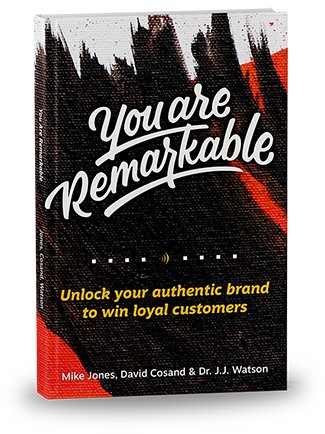Which came first?
The product or the organization?
While in many cases, the product stands tall—the splash it made, the awareness it sparked, and the customer loyalty it built. But even in those instances, you can make a good case for the organization. If we extend organization to mean the sum total of vision, history, testing, collaboration, and external circumstances that went into making a product work, well…then no product exists without an underlying organization.
Of course, if we’re only talking about organizations that have a product, none of them would ever exist without that product…
We could do this all day.
All semantics aside, the obvious realities of branding, building your company and reaching your audience require careful, constant attention to both product and organization. Building on last month’s topic (Turning Your Single Product Brand into an Authentic Corporate Identity), this time around, we’re digging into the differences between branding your product and branding your organization with a two-part series.
While they’re not quite the chicken and the egg, individual products and the organization that houses them can both thrive with the right approach—and in the end, with the right understanding of the audience, you’re building a relationship with.
But building each into a coherent, overarching brand, in many ways, means recognizing product and organization for what they really are.
Molten lava and dry ice.
Product Branding Basics
Of course product branding matters.
While you might think that branding your product so that people can identify it, build an association with it, and come to trust it might be a no-brainer…I’ve actually talked to manufacturers who don’t grasp that reality. While I’m painting manufacturers with a pretty broad brush here (and all the ones I’ve met excel at what they do), they can fall into the trap of not thinking about product branding at all: “I make really cool, high-quality stuff. Why wouldn’t people flock to the store and want to buy it?”
I’m not kidding.
But Who Needs It?
Those who passed branding (or marketing) 101 know that just making an amazing product isn’t enough. The first question is always: who’s the product for? Which audience in particular? Which demographic, age group, gender, nationality, regional background, and for what interest, reason, or purpose?
Even more than all the cool stuff you can do with a product, people need to know who it’s for. In short, the audience is a huge ingredient, and maybe the most important reason to distinguish between a product brand and a larger, organizational brand.
If you think about the fact that few products and companies stay the same forever, anchoring your branding effort with an organization, and not just one product, makes a lot of sense. Products change as companies grow, and when a product changes, so will its audience. If your company grows into a different area, starts developing products for a different sector, or doesn’t want to stay with one product, any of those changes means building a new relationship with your audience.
Not thinking about who your new product is for, how customers will perceive it, and what relationship that new product might establish with your overall brand means going wherever the wind takes you…and it could even mean getting stuck as a single product company with your product itself is the brand.
Jeep: Using a Strong Brand Resonance to Introduce a New Product
You have a relationship with the people that you’re selling to and vice versa.
Customers have a relationship with your organization or company, but they also have a relationship with your specific product or service.
Both building an organizational brand and developing new products means building new relationships with audiences…and Jeep is one brand—one with strong name recognition and brand association with one product—that has done that quite well.
When you think of Jeep, you probably imagine their classic, off-roading vehicle; the one that you can drive off the lot for around $60,000. But they also offer a $90,000 more luxurious version: the Grand Wagoner. Many people love Jeep…but not all of them can shell out $90,000. Knowing that people associated its brand name with a particular vehicle, Jeep had to extend its reach to build a new audience—high-earning executives looking for pricier off-road capable vehicles.
Because of their strong brand association with a single product, Jeep was able to carry positive resonance with one product over to its organizational identity, and from there to a product made for wealthier customers who love Jeep but may never go off-roading.
The Grand Wagoner caught on because people (off-roaders and executives alike) had bought into a winsome, positive, organizational brand. While people might even like Jeep for different reasons (off-roading, or simply because they’re spacious, reliable, and maneuverable), they’re apt to see newer vehicles with the same loyalty and resonance they have for the overall brand.
And that’s not by accident…it’s because Jeep carefully extended their brand to accommodate a new audience: one tailored directly to their new vehicle line.
Salesforce: Keep Your Products Under One Roof
Salesforce is another good example of an organization that is offering a huge variety of different solutions (i.e. products), but offering all of them under one brand name.
Each one of Salesforce’s business solutions—with some being geared toward marketing, sales, analysis and finance, and others being geared toward customer relations—fit the particular needs of their customer. Each product speaks to each audience in a particular way, but while still being Salesforce.
If (like us), you knew Salesforce back in the day, you’d be surprised at everything they’re offering now. But rather than letting the tail wag the dog (by that I mean letting new products drag the company brand all over the map), Salesforce, like Jeep, is another example of how organizational brands can carry the weight of recognition, while allowing products to build and maintain trust with their audience.
Product and Brand Organization Reflect on Each Other
People in business trust those products because they work; and also because they’re tailored and marketed to their particular needs. But each product is clearly Salesforce…and as a company, Salesforce isn’t ‘cruising’ because everything’s fine.
Rather, they’re paying constant attention to each product and making sure it fits the needs and applications of the product they’re selling to.
Not thinking about your product’s branding, and whether or not your product is meeting the needs of the audience you’re marketing to can quickly spell problems. If a product has problems or grows issues over time, you can get hammered… and both your product and your brand’s reputation will suffer.
So when it comes to product branding, think bigger.
Think about your product’s audience, what they need and what relationship your product is building with them.
Finally, think about your product’s branding in relation to your whole organization. If both are strong (as in Jeep or Salesforce), then your brand’s resonance can carry over from one to the other, and support your efforts to extend your efforts to introduce new products and reach new audiences.
A Few More Thoughts on Product Branding
If you’ve got new products, or if you’re angling for a new market, what do you need to think about in terms of organizational branding?
With this being a two-part blog series, we’ll be focusing on that topic next month.
Meanwhile, and with B2B’s in mind, any company launching a new product, or aiming to build relationships with a new audience should run through a checklist of thoughtful, detailed branding questions.
A few essential branding-focused questions to ask before launching a new product:
- Who’s the audience?
- Why this audience? What about their needs, interests, region, or desires primes them to resonate with this product?
- What thoughts will this new product generate about your brand as a whole (hint: good ones never hurt).
- How does this new product or solution fit into the larger story of your company? How does it harmonize with your values, your purpose, and your vision for a small corner of the world that’s made better by what you do?
- Will this new product make sense to audiences, given what they know and feel about your overall brand? In other words, is this new product a clean fit, or more of a fish out of water?
- Finally, how will this new product affect the perception of my other products? Like Taser International, will security drones seem, at first, like a stretch? Or like Jeep and the Grand Wagoner, will the positive brand association of a popular product carry over to a new product, and bring the potential to activate new audiences for different reasons?
Whew.
That’s more than enough to chew on for now.
A Word on Wildly Different Products
One final thought on product branding: if you’re in the business of wildy exploring new ideas, or experimenting with the products and services you offer (hey, it’s all about what sells right?), be careful.
Launching a new product or service that’s starkly different from your brand and your brand’s relationship with customers comes with many liabilities. Rather than trying to shoehorn a wildly different product into your brand, it might be time to consider a side venture…and launch a new brand altogether with its own mission, values, audience, and of course, product.
While I’ll explore this topic a little more next month, it’s not entirely unrelated to the question of how to brand products well, and in sync with your organization’s brand and purpose.
In the end, products that are branded thoughtfully, and with a particular audience in mind communicate what customers need to know. And while there’s few substitutes for a strong, positive organizational brand, thinking about products always means considering your audience—what they need, how they need to be approached, and what a relationship with you, and your product will entail.
If the audience is the brand builder’s burden, then it’s a glorious one.
Whatever product or service you offer, serving it well and helping people who need it find it is intrinsically fruitful.
Not to mention remarkable.
And On That Note…
If you’d like some sound feedback on serving your audience by branding your products well, give the Resound team a shout.
We eat, sleep, and breathe branding, and we’ve worked with B2B’s offering a range of services, from asset-based lending to cryptocurrency services, from business consultation to virtual customer service…and from milk and dairy products to heavy-duty, automated packaging machinery.
Every product and service has the potential to make life better, and we’re excited to help any B2B company learn more about how to market, tailor, and promote products in a particular way that shows how remarkable they are.
There’s much, much more in my B2B branding book “You are Remarkable”, as well as in the articles and podcasts posted on our website.
Until next time, happy branding.



